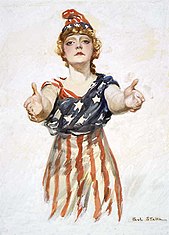Culture of the United States
From Wikipedia, the free encyclopedia
The culture of the United States of America, also referred to as American culture, encompasses various social behaviors, institutions, and norms in the United States, including forms of speech, literature, music, visual arts, performing arts, food, religion, law, technology as well as other customs, beliefs, and forms of knowledge. American culture has been shaped by the history of the United States, its geography, and various internal and external forces and migrations.
| This article is part of a series on the |
| Culture of the United States |
|---|
 |
| Society |
| Arts and literature |
| Other |
| Symbols |
|
United States portal |
Its Western foundations derive from European colonization, and it was shaped early on by interactions with various indigenous groups and the forced migration of enslaved Africans. Since the United States was established in 1776, its culture has been influenced by successive waves of immigrants, and the resulting cultural diversity has been a distinguishing feature of society in the United States. The United States is a primarily anglophone country with a legal system derived from English common law.[1]
Culture in the United States can vary by factors such as region, race and ethnicity, age, religion, socio-economic status, or population density, among others. Different aspects of American culture can be thought of as low culture or high culture, or belonging to any of a variety of subcultures.
The United States exerts major cultural influence on a global scale and is considered a cultural superpower.[2][3]
.png/175px-Uncle_Sam_(pointing_finger).png)
